In today’s data-driven environment, efficient data integration is essential for businesses to gain insights and make informed decisions. SQL Server Integration Services (SSIS) is a popular tool for ETL (Extract, Transform, Load) processes, allowing organizations to integrate data from various sources, including MySQL and MariaDB. Connecting these databases to SSIS can unlock substantial benefits, enabling seamless data transfer, improved analytics, and enhanced reporting capabilities.
What is SSIS?
SSIS is a robust data integration platform from Microsoft, primarily designed for automating data migration and transformation tasks. It allows users to extract data from various sources, transform it into the required format, and load it into a destination such as a data warehouse or another database. By enabling integration between different systems, SSIS is key in bridging the gap between relational databases, cloud services, and non-relational data stores.
Why Connect to MySQL and MariaDB?
MySQL and MariaDB are widely used open-source relational database systems that power many web applications, content management systems (CMS), and enterprise solutions. Connecting SSIS to these databases is crucial for businesses that rely on them for operational or analytical purposes. Common reasons for integrating MySQL or MariaDB with SSIS include:
Data Consolidation: Organizations often use MySQL or MariaDB alongside other databases, such as SQL Server. SSIS allows for the consolidation of data from these sources into a single environment, simplifying reporting and analysis.
Data Migration: When migrating data from MySQL or MariaDB to another system, SSIS can streamline the process, handling complex ETL tasks with ease.
Real-time Data Synchronization: Businesses that require real-time data updates across multiple systems can leverage SSIS to synchronize MySQL and MariaDB with other data stores, ensuring consistency.
Cross-Platform Reporting: SSIS enables businesses to incorporate data from MySQL or MariaDB into SQL Server Reporting Services (SSRS), facilitating cross-platform reporting.
Tools for Connecting MySQL and MariaDB to SSIS
While SSIS natively supports many popular data sources, connecting it to MySQL or MariaDB requires third-party components or drivers. Several solutions exist to bridge this gap, but one standout option is Devart SSIS for MySQL: https://www.devart.com/ssis/mysql/how-to-connect-mysql-using-ssis.html
Devart SSIS for MySQL offers specialized data flow components that allow direct connection between SSIS and MySQL or MariaDB databases. This tool is beneficial for users who want a smooth integration experience without needing to configure complex ODBC or ADO.NET providers manually. Key benefits of using Devart SSIS for MySQL include:
Easy Setup: Devart's components integrate directly into the SSIS environment, making the setup straightforward.
High Performance: It ensures high-speed data processing with minimal resource usage.
Compatibility: Full support for MySQL and MariaDB versions, including cloud-based databases like Amazon RDS for MySQL.
Benefits of Using SSIS for Data Integration
SSIS simplifies data handling between different databases, making it an essential tool for companies looking to harmonize data from MySQL or MariaDB with SQL Server systems. This integration improves data governance, enhances business intelligence capabilities, and boosts operational efficiency.
In conclusion, integrating MySQL or MariaDB with SSIS using tools like Devart SSIS for MySQL provides businesses with the flexibility to manage and analyze their data more effectively, making it a powerful approach to modern data integration strategies.








